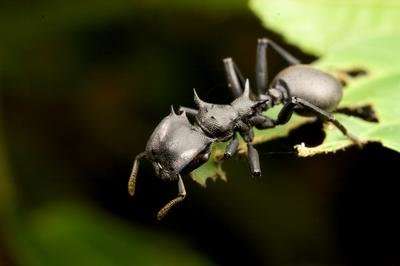Ants in the Amazon rainforest canopy have vastly more bacteria in their guts than ground dwellers

UC San Diego Center for Microbiome Innovation (CMI) researchers and colleagues on the East Coast have for the first time quantified the number of bacteria in the guts of a broad range of ant species in the Amazon rainforest. They found that the primarily herbivorous ants that live in the canopy have orders of magnitude more bacteria than those that live on the ground. The work has implications for the way microbiome studies are conducted. The authors published the study July 27 in Integrative and Comparative Biology.
When tropical entomologists began systematic surveys of arthropod biomass in rainforest canopies, they were surprised to find that ants made up the majority of it. The problem centered around an apparent inversion of the classic terrestrial ecosystem biomass pyramid: ants were presumed to be predators, yet they outweighed their potential prey.
This biomass "paradox" was partly resolved in 2003 when scientists found evidence that most ants that live in the rainforest canopy are herbivores that feed on plant-derived liquid like sap and nectar – but that presented another dilemma: nitrogen, a necessary biological nutrient, is limited in these resources. How do these herbivorous canopy ants acquire enough nitrogen to grow their colonies?
"It's known that insects with nutrient-imbalanced diets frequently rely on bacterial symbioses to complement their nutritional demands," said Jon Sanders, the lead author on the paper and postdoc in CMI faculty director Rob Knight's lab, which is in the UC San Diego School of Medicine. In fact, the carpenter ant's Blochmannia bacteria were among the first bacteria discovered to have a symbiotic relationship with their host, and appear to play a role in upgrading or recycling nitrogen, Sanders said.
"100 years after this discovery, it was found that specialized extracellular bacteria inhabit the morphologically elaborated guts of the new-world arboreal genus Cephalotes - common name 'turtle ants', also recently made famous for their gliding abilities," said Sanders, who published a paper on the evolution of these bacteria in 2014. "We know they're there – that concept isn't new."
But what is new is the way this study was conducted – using quantitative, rather than qualitative, methods to understand just how many of them are there, and the biological significance of their presence.
Current sequencing techniques almost always start with an amplification step in which the original template DNA is copied many times. The resulting libraries retain almost no information about the number of bacteria that were present to begin with.
"The amplification step can be subject to contamination, especially for samples like ants that have very low starting DNA concentrations," said Sanders. "Even in the absence of contamination, the biological implications of very low density bacterial communities are likely to be substantially different than for highly abundant symbionts. Without additional information about absolute abundance, it can be difficult to draw meaningful biological conclusions from diversity."
Sanders and his team used two independent methods – quantitative PCR (qPCR) and fluorescence microscopy, which entailed carrying a 60 lb microscope through the Amazon – to assess the absolute abundance of bacterial cells.
What they found was surprising – the herbivorous ants that live in the canopy have three to four orders of magnitude more bacteria in their gut than ground-dwelling ants.
Scaled to human size, that's about the size of a two-liter bottle of soda. Comparatively, ground-dwelling ants contain enough bacteria to equal the size of a roasted coffee bean.
"This indicates that they play an important role," said Sanders. "Presumably having to do with sustaining large nutrient fluxes."
Strangely, however, the researchers didn't see the same bacteria present in every herbivorous genera – so why do canopy-dwelling ants need so much bacteria in their guts, and why doesn't it seem to matter which ones? And just how did those relationships come to be? Science will tell, says Sanders.
"We typically think of a microbiome as something that an animal has," said Sanders. "But I think we are learning that what it means to have a microbiome is categorically different among animals, and that absolute abundance data is necessary to understand its biological significance."
Provided by University of California - San Diego





















